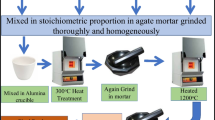Abstract
SODIUM niobate forms solid solutions of perovskite type structure with the niobates of potassium1, cadmium2 and lead3. At quite low concentrations of the latter in these compositions the room temperature orthorhombic antiferroelectric structure of pure sodium niobate (NaNbO3) gives place to an orthorhombic ferroelectric form. The phase-change between these two structures has not, however, been observed in any of these systems. In the ceramic specimens which have been examined, the ferroelectric properties increase gradually over a range of compositions. Pure sodium niobate single crystals, on the other hand, show double hysteresis loops at high fields4 suggesting a discontinuous change to a ferroelectric form.
Similar content being viewed by others
References
Shirane, G., Newnham, R., and Pepinsky, R., Phys. Rev., 96, 581 (1954).
Lewis, B., and White, E. A. D., J. Electronics, 1, 646 (1956).
Lewis, B., and Fancombe, M. H., J. Electronics, 2, 387 (1957).
Cross, L. E., and Nicholson, B. J., Phil. Mag., 46, 212 (1955).
Cross, L. E., Phil. Mag. 1, 76 (1956).
Author information
Authors and Affiliations
Rights and permissions
About this article
Cite this article
CROSS, L. Electric Double Hysteresis in (Kx Na1-x)NbO3 Single Crystals. Nature 181, 178–179 (1958). https://doi.org/10.1038/181178a0
Issue Date:
DOI: https://doi.org/10.1038/181178a0
- Springer Nature Limited
This article is cited by
-
Effect of ZnO on the microstructure and electrical properties of (K0.5Na0.5)NbO3 lead-free piezoelectric ceramics
Journal of Materials Science: Materials in Electronics (2012)
-
Giant electric-field-induced strains in lead-free ceramics for actuator applications – status and perspective
Journal of Electroceramics (2012)
-
Ferroelectric and piezoelectric properties of new NaNbO3–Bi0.5K0.5TiO3 lead-free ceramics
Journal of Materials Science: Materials in Electronics (2010)
-
Dielectric properties of Na1-x K x NbO3 in orthorhombic phase
Bulletin of Materials Science (2003)




